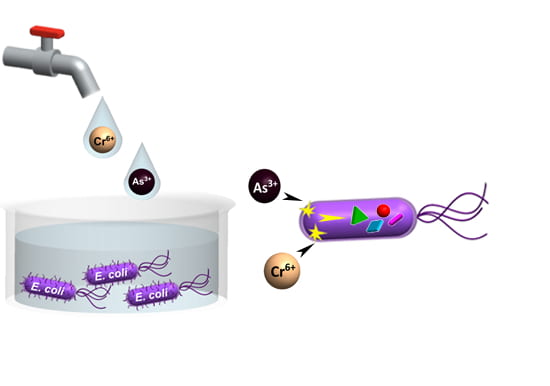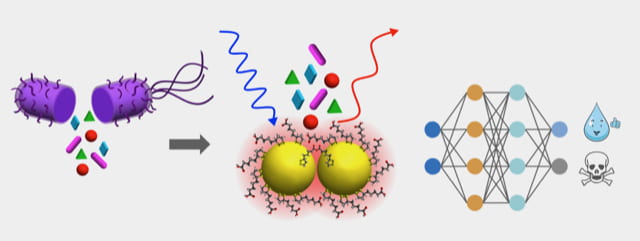| Feb 23, 2023 |
Researchers create E. coli-based water monitoring technology
|
|
(Nanowerk News) People often associate Escherichia coli with contaminated food, but E. coli has long been a workhorse in biotechnology. Scientists at the University of California, Irvine have demonstrated that the bacterium has further value as part of a system to detect heavy metal contamination in water.
|
|
E. coli exhibit a biochemical response in the presence of metal ions, a slight change that researchers were able to observe with chemically assembled gold nanoparticle optical sensors. Through a machine-learning analysis of the optical spectra of metabolites released in response to chromium and arsenic exposure, the scientists were able to detect metals in concentrations a billion times lower than those leading to cell death – while being able to deduce the heavy metal type and amount with higher than 96 percent accuracy.
|
|
The process, which the researchers said can be accomplished in about 10 minutes, is the subject of a study appearing in Proceedings of the National Academy of Sciences ("Decoding the metabolic response of Escherichia coli for sensing trace heavy metals in water").
|
 |
| Contaminated water is a major source of toxic heavy metal exposure for animals and people. The metabolic stress response of E. coli is used to detect the presence of toxic metals in tap water and wastewater. Difficult to detect heavy metal ions are thereby converted to more easily detectable chemical signals. (Image: Regina Ragan / UCI)
|
|
“This new water monitoring method developed by UCI researchers is highly sensitive, fast and versatile,” said co-author Regina Ragan, UCI professor of materials science and engineering. “It can be broadly deployed to monitor toxins at their sources in drinking and irrigation water and in agricultural and industrial runoff. This system can provide an early warning of heavy metal contamination to safeguard human health and ecosystems.”
|
|
In addition to proving that bacteria like E. coli can detect unsafe water, the researchers spotlighted the other necessary components – gold nanoparticles assembled with molecular precision and machine learning algorithms – which greatly enhanced the sensitivity of their monitoring system. Ragan said it can be applied toward spotting metal toxins – including arsenic, cadmium, chromium, copper, lead and mercury – at levels orders of magnitude below regulatory limits to provide early warning of contamination.
|
|
In the study, the scientists explained that they can apply trained algorithms to unseen tap water and wastewater samples, which means the system can be generalized to water sources and supplies anywhere in the world.
|
|
“This transfer learning method allowed the algorithms to determine if drinking water was within U.S. Environmental Protection Agency and World Health Organization recommend limits for each contaminant with greater than 96-percent accuracy and with 92-percent accuracy for treated wastewater,” Ragan said.
|
 |
| After heavy metal exposure, the contents (lysate) of E. coli cells are examined with a sensitive optical sensor composed from gold nanoparticles which are optimized to detect at levels of one metal toxin per bacterium in solution. Machine learning algorithms learn the chemical fingerprint of the stress response, which is unique to the type and quantity of metal toxin, from the optical spectra. Fine-tuned models then determine if an unknown water sample is safe. (Image: Regina Ragan / UCI)
|
|
“Access to safe water is necessary for the health of people and the planet,” she added. “New technology that can be mass manufactured at low-cost is needed to monitor the introduction of an array of contaminants in the water supply as a critical part of the solution for water security in the face of pollution and climate change.”
|


